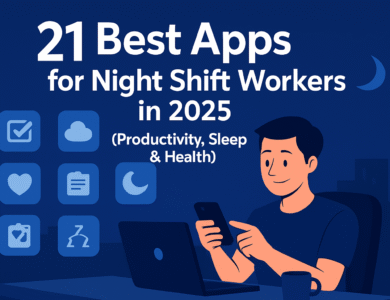
Night shift workers often find it hard to pursue their interests, like learning new languages. Their schedules don’t fit well with traditional study times. But now, thanks to new tools, they can learn in flexible, personalized ways.
Duolingo AI is changing how we learn languages. It’s perfect for night shift workers who need to study when they can. With AI-driven language learning, you can learn whenever and wherever you want.
Key Takeaways
- Duolingo AI offers flexible language learning for night shift workers.
- Personalized learning experiences adapt to individual schedules.
- AI-driven technology enhances engagement and effectiveness.
- Night shift workers can learn at their own pace.
- Flexible study routines accommodate unconventional work schedules.
The Unique Language Learning Challenges for Night Shift Workers
Night shift workers face unique challenges when learning a new language. Their irregular schedules are a big part of the problem. These issues fall into three main areas: sleep patterns, access to classes, and social isolation.
Irregular Sleep Patterns and Cognitive Function
Irregular sleep can hurt how well you think and learn. It’s harder to focus and remember new words and rules. Studies show sleep loss can mess with memory and language skills.
Limited Access to Traditional Language Classes
Daytime classes are tough for night shift workers to attend. They need to find other ways to learn, like online courses or apps like Duolingo AI.
Social Isolation and Practice Opportunities
Night shift workers often feel alone because of their schedules. This makes it hard to practice speaking and get better at pronunciation.
| Challenge | Impact on Language Learning |
|---|---|
| Irregular Sleep Patterns | Affects cognitive function, memory, and retention |
| Limited Access to Classes | Restricts opportunities for structured learning |
| Social Isolation | Reduces opportunities for speaking practice and feedback |
It’s important to understand these challenges to find good ways to learn a new language at night. Knowing these issues helps learners use tools like Duolingo AI to succeed.
Duolingo AI for Night Shift Language Learning: An Overview
Duolingo AI has changed language learning for night shift workers. It fits their unique schedules. This is key for those with irregular hours who need a tool that matches their lifestyle.
How Duolingo AI Adapts to Irregular Schedules
Duolingo AI’s flexibility is a big plus for night shift workers. It does this in a few ways:
- Smart Notifications and Reminders: The AI sends alerts and reminders based on the user’s schedule. This helps them stay on track, even on irregular days.
- Personalized Learning Paths: Duolingo AI looks at the user’s habits and schedule. It then creates a learning path that fits their availability.

Key Features Beneficial for Night Workers
Duolingo AI has features that help night shift workers a lot:
- Night Mode and Low-Light Options: The app’s night mode eases eye strain. It’s perfect for late-night use.
- Offline Learning Capabilities: Night shift workers can download lessons for offline use. This lets them learn during breaks without needing internet.
These features, along with the AI’s adaptability, make Duolingo great for night shift workers. It offers a flexible, personalized, and accessible learning experience. Duolingo AI helps night shift workers reach their language learning goals, even with tough schedules.
Setting Up Your Duolingo AI Profile for Night Shift Success
Setting up your Duolingo AI profile for night shifts can really help your learning. By adjusting your account to match your schedule, you can learn more, even at odd hours.
Step-by-Step Account Configuration
First, log in to Duolingo and go to settings. Here, you can make your profile fit your night shift life. Make sure your time zone is right so you get the right updates.
Customizing Notification Settings for Your Shift
It’s key to set up your notifications right for night shifts. You can change when you get reminders to match your breaks or when you’re most awake. This helps you catch up on learning.
| Notification Type | Recommended Setting for Night Shift |
|---|---|
| Daily Reminders | Set to your pre-shift preparation time |
| Practice Reminders | Schedule during your breaks |
| New Content Notifications | Enable for immediate updates |
Setting Realistic Learning Goals Based on Your Schedule
It’s important to set goals that fit your night shift. Duolingo AI lets you set daily goals that you can change as needed. Be honest about how much time you can spend learning each day.
As Duolingo’s language learning expert says, “Setting realistic goals is key to staying motivated and making steady progress in language learning.”
By following these steps and using Duolingo AI’s tools, night shift workers can make a learning plan that works for them. This makes learning a language easier and more effective.

Creating an Effective Language Learning Routine Around Night Shifts
Learning a new language while working night shifts needs a special plan. It’s important to find the best times to study and make a study plan that fits your schedule.
Identifying Your Peak Cognitive Hours
Knowing when you’re most alert is key. Night shift workers might not be most focused in the morning. Notice when you feel most energetic and focused to plan your study times.

Structuring 10-15 Minute Learning Sessions During Breaks
Use your short breaks to learn a new language. Duolingo AI makes it easy to fit in 10-15 minute sessions. This keeps your learning consistent without feeling too much.
Building Pre-Shift and Post-Shift Learning Habits
Adding learning to your routine before and after work can really help.
Morning Wind-Down Routine
After a night shift, listening to language lessons or podcasts is a great way to relax. It keeps your mind engaged with the language while you unwind.
Pre-Sleep Learning Techniques
For some, a quick review before bed works well. Use flashcards or quick exercises on Duolingo AI to refresh your memory. This helps without keeping you awake.
By following these tips, you can keep learning a new language, even with a night shift schedule. Being consistent and flexible is crucial to succeed.
Step-by-Step Guide to Using Duolingo AI Features During Night Hours
Night shift workers can really benefit from Duolingo’s AI features. These are made for their special schedules. They help learners fit their study time into their odd hours.
Activating and Customizing Night Mode
First, turn on Night Mode in Duolingo. It makes the app screen darker, which is easier on your eyes in the dark. To do this, go to your Duolingo settings, pick “Appearance,” and turn on “Night Mode.” You can also adjust the screen brightness to feel more comfortable.

Downloading Lessons for Offline Access
For those with little internet at night, Duolingo’s offline feature is a lifesaver. To download lessons, open your course, tap the three dots (⋯) or “More,” and choose “Download for offline use.” This lets you keep learning without the internet, making the most of your time.
Using Voice Recognition Features in Quiet Environments
Duolingo’s voice recognition is great for improving your speaking. Use it when it’s quiet during your shift. The AI checks your pronunciation and gives you feedback to improve your accent and tone.
Accessing Duolingo Stories During Downtime
Duolingo Stories are fun for practicing reading and vocabulary. Use them during breaks to dive into the language. The AI adjusts the stories to your level, so you’re always learning but not too stressed.
By using Duolingo AI’s features, night shift workers can make a good language learning plan. This plan fits their unique schedules. It helps them make progress, even when it’s not the usual time.
Maximizing AI-Powered Personalization for Faster Progress
Night shift workers can speed up their language learning with Duolingo’s AI. Duolingo’s AI adjusts to your learning style, perfect for those with odd schedules.
Understanding How the AI Tracks Your Performance
Duolingo’s AI watches your progress through accuracy, speed, and consistency. It changes lessons to fit your learning pace. This keeps you challenged but not too hard.
Utilizing Spaced Repetition for Better Retention
Duolingo’s AI uses spaced repetition to help you remember. It reviews material at the best times. This is great for night shift workers, fitting in during breaks or before/after shifts.
Adjusting Difficulty Based on Energy Levels
Duolingo’s AI changes the difficulty based on your energy and performance. For night shift workers, it offers harder exercises when you’re alert and easier ones when you’re tired.
Hard Exercises During Alert Hours
When you’re most alert, Duolingo’s AI gives you tough exercises. This helps you learn as much as you can during focused times.
Review Sessions During Low-Energy Periods
When you’re tired, the AI makes lessons easier. These sessions help you remember what you’ve learned. This way, you keep your language skills sharp, even on tired days.
| Energy Level | AI-Adjusted Activity | Learning Benefit |
|---|---|---|
| High | Challenging Exercises | Maximizes learning potential |
| Low | Review Sessions | Reinforces previously learned material |
By using Duolingo’s AI, night shift workers can learn languages faster. This personalized learning fits even the most irregular schedules, making progress both effective and efficient.
Supplementing Duolingo AI with Other Night Shift-Friendly Learning Methods
Duolingo AI is great for night shift workers, but adding other methods can help more. Night shifts offer a chance to learn a new language in unique ways.
Complementary Audio Resources for Passive Learning
Using audio resources is a smart way to boost your learning. Listen to podcasts, audiobooks, or apps during breaks. It’s especially good for night shift workers.
Some top picks include:
- Podcasts like “Coffee Break” or “News in Slow”
- Audiobooks on platforms like Audible
- Language learning apps with audio content
Integrating Physical Flashcards for Screen Breaks
Flashcards are a great way to take a break from screens. They help remember vocabulary. Night shift workers can make or use flashcards during free time.
| Flashcard Type | Benefits |
|---|---|
| Pre-made Flashcards | Convenient, Saves Time |
| Self-made Flashcards | Personalized, Enhances Memory |
Finding Language Exchange Partners in Similar Time Zones
Language exchange partners are key for speaking practice and cultural insights. Night shift workers can find partners on apps or websites with similar schedules.
Some great places to find partners include:
- Tandem
- HelloTalk
- Conversation Exchange
By mixing Duolingo AI with these methods, night shift workers can make a solid language learning plan. It fits their unique schedules perfectly.
Tracking Progress and Maintaining Motivation on Irregular Schedules
Night shift workers face unique challenges in language learning. Duolingo AI offers a solution to stay on track. It’s key to keep motivated and track progress, especially with irregular schedules.
Using Duolingo’s Streak and Achievement Systems
Duolingo’s streak and achievement systems help keep learners motivated. By keeping a daily streak, night shift workers can track their consistency. The achievement system rewards progress, giving a sense of accomplishment.
Setting Micro-Goals for Each Shift
Setting micro-goals for each shift helps stay focused. Goals can be simple, like completing a certain number of lessons. This makes learning manageable and less overwhelming.
Creating Rewards That Work With Your Lifestyle
Creating a reward system that fits your lifestyle is key. Rewards can be based on shifts or weekly achievements.
Shift-Based Rewards
Shift-based rewards are given after consistent learning over a few shifts. For example, after five shifts, treat yourself to a favorite meal or activity.
Weekly Achievement Celebrations
Weekly achievement celebrations reflect on your progress. This could mean treating yourself to something special or sharing your achievements with friends and family.
| Reward Type | Frequency | Example |
|---|---|---|
| Shift-Based | After 5 shifts | Favorite meal |
| Weekly Achievements | End of week | Sharing progress with friends |
By using these strategies, night shift workers can track progress and stay motivated. This makes the most of their Duolingo AI language learning experience.
Overcoming Common Challenges for Night Shift Language Learners
Night shift workers face special challenges when learning a new language. But, with the right strategies, they can beat these hurdles. Learning a language on irregular schedules needs flexibility, resilience, and tools like Duolingo AI for night shift workers.
Combating Fatigue and Brain Fog
Fatigue and brain fog are big problems for night shift workers. They make learning a language hard. To fight these issues, it’s key to find ways to boost energy and brain power.
Strategic Caffeine Use for Learning Sessions
Drinking caffeine wisely before or during study can help stay alert and focused. But, too much can cause jitters and a crash later.
Physical Movement Before Study Sessions
Doing some physical activity or light exercise before studying can help. It gets blood flowing to the brain, boosting thinking and fighting off tiredness.
Maintaining Consistency During Schedule Changes
Night shift workers often have changing schedules, which can mess up their study plans. To stay consistent:
- Adjust your study schedule as your shifts change.
- Use a calendar or planner to keep track of shifts and plan study sessions.
- Download lessons for offline use on days off or during breaks to keep up with learning.
Balancing Learning with Recovery Time
It’s vital for night shift workers to balance learning with rest. Make sure to:
- Rest and recover well on days off.
- Set achievable goals that match your energy and schedule.
- Use downtime, like commutes or breaks, for listening to language podcasts.
By using these strategies and Duolingo AI, night shift workers can tackle common challenges. They can make real progress in learning a new language.
Conclusion: Embracing Language Learning as a Night Shift Worker
Night shift workers can now use Duolingo AI to learn new languages. This breaks down old barriers. Duolingo AI fits into irregular schedules, offering a flexible and personalized learning experience.
Duolingo AI for night shift language learning turns breaks and downtime into learning chances. The AI adjusts to your pace and energy, making learning effective.
By adding Duolingo AI to their routine, night shift workers can make great strides in language learning. The secret is being consistent and using the platform’s features well.
Using Duolingo AI for language learning opens doors to personal and professional growth. It shows how technology can meet diverse learning needs, even for those with non-traditional schedules.
FAQ
How does Duolingo AI adapt to irregular night shift schedules?
Duolingo AI adjusts to your night shift with smart notifications and learning paths. It makes sure you can learn at any time.
Can I use Duolingo AI offline during my night shift?
Yes, you can use Duolingo AI offline. It lets you download lessons. So, you can learn even without internet.
How can I customize Duolingo AI to fit my night shift schedule?
To customize Duolingo AI, adjust your account settings and notifications. Set goals that fit your schedule. This way, learning fits your life.
Is Duolingo AI suitable for night shift workers with varying energy levels?
Yes, Duolingo AI is great for those with changing energy. Its spaced repetition and difficulty adjustment help you learn, even when tired.
Can I use Duolingo AI’s voice recognition feature during night shifts?
Yes, you can use the voice recognition feature quietly. It’s perfect for practicing pronunciation without disturbing others.
How can I stay motivated while learning a language as a night shift worker?
Stay motivated with Duolingo’s streak and achievement systems. Set small goals for each shift. Create rewards that match your lifestyle.
Are there any additional learning methods that complement Duolingo AI for night shift workers?
Yes, try audio resources for passive learning. Use physical flashcards for breaks. Find language exchange partners in your time zone. These methods can boost your learning.
How does Duolingo AI help with tracking progress on irregular schedules?
Duolingo AI tracks your progress and gives insights. It helps you stay on track, even with unpredictable schedules.



